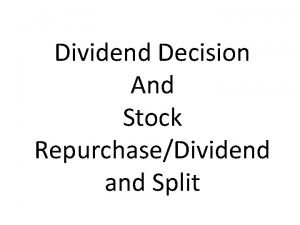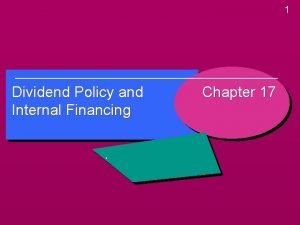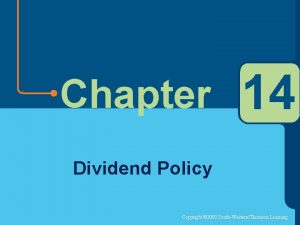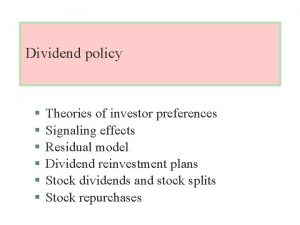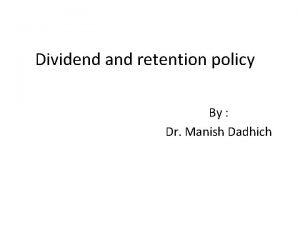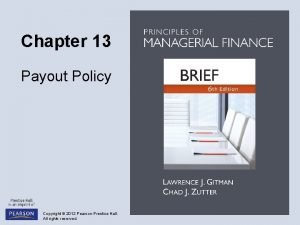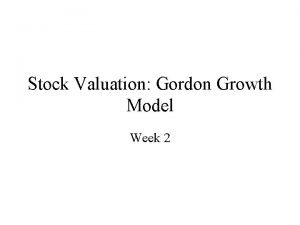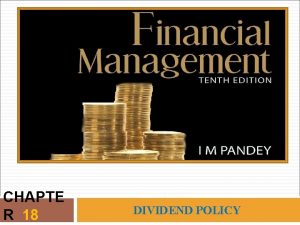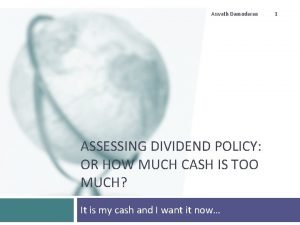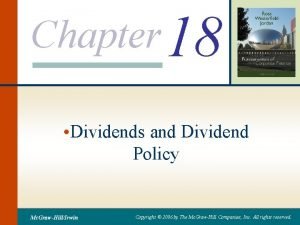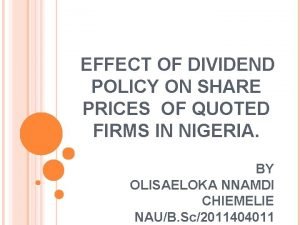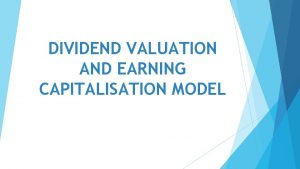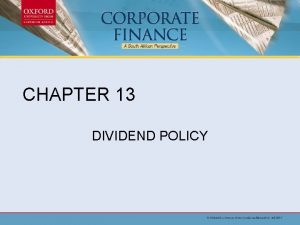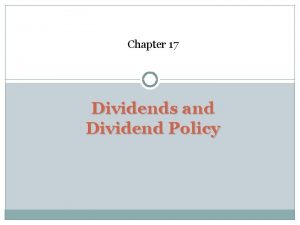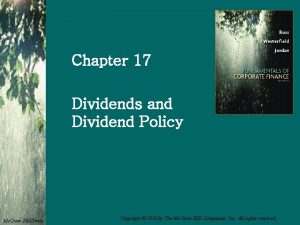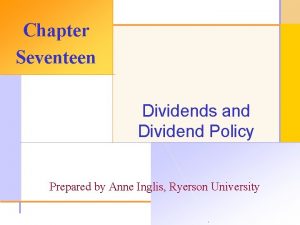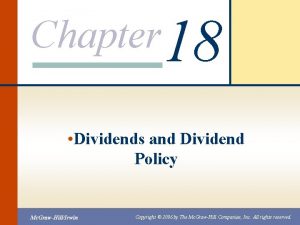7 1 Outline 7 Dividend Policy How Dividends












- Slides: 12

7 - 1 Outline 7: Dividend Policy ÜHow Dividends are Paid ÜHow Do Companies Decide on Dividend Payments ÜWhy Dividend Policy Should Not Matter ÜWhy Dividends May Increase Firm Value ÜWhy Dividends May Reduce Firm Value

7 - 2 Dividend Payments Cash Dividend - Payment of cash by the firm to its shareholders. Ex-Dividend Date - Date that determines whether a stockholder is entitled to a dividend payment; anyone holding stock before this date is entitled to a dividend. Record Date - Person who owns stock on this date received the dividend.

7 - 3 Dividend Payments Stock Dividend - Distribution of additional shares to a firm’s stockholders. Stock Splits - Issue of additional shares to firm’s stockholders. Stock Repurchase - Firm buys back stock from its shareholders.

7 - 4 Dividend Payments Mar 8 Mar 19 Declaration date Withdividend date Mar 20 Ex-dividend date Share price falls Mar 22 Record date Apr 18 Payment date

7 - 5 Stock Dividend Example - Amoeba Products has 2 million shares currently outstanding at a price of $15 per share. The company declares a 50% stock dividend. How many shares will be outstanding after the dividend is paid? Answer 2 mil x. 50 = 1 mil + 2 mil = 3 mil shares

7 - 6 Stock Dividend Example - cont - After the stock dividend what is the new price per share and what is the new value of the firm? Answer Ü The value of the firm was 2 mil x $15 per share, or $30 mil. After the dividend the value will remain the same. Ü Price per share = $30 mil / 3 mil sh = $10 per sh.

7 - 7 The Dividend Decision Lintner’s “Stylized Facts” (How Dividends are Determined) 1. Firms have longer term target dividend payout ratios. 2. Managers focus more on dividend changes than on absolute levels. 3. Dividends changes follow shifts in long-run, sustainable levels of earnings rather than short-run changes in earnings. 4. Managers are reluctant to make dividend changes that might have to be reversed.

7 - 8 Dividend Policy is Irrelevant ÜSince investors do not need dividends to convert shares to cash they will not pay higher prices for firms with higher dividend payouts. In other words, dividend policy will have no impact on the value of the firm.

7 - 9 Dividends Increase Value Market Imperfections and Clientele Effect There are natural clients for high-payout stocks, but it does not follow that any particular firm can benefit by increasing its dividends. The high dividend clientele already have plenty of high dividend stock to choose from. These clients increase the price of the stock through their demand for a dividend paying stock.

7 - 10 Dividends Increase Value Dividends as Signals Dividend increases send good news about cash flows and earnings. Dividend cuts send bad news. Because a high dividend payout policy will be costly to firms that do not have the cash flow to support it, dividend increases signal a company’s good fortune and its manager’s confidence in future cash flows.

7 - 11 Dividends Decrease Value Tax Consequences Companies can convert dividends into capital gains by shifting their dividend policies. If dividends are taxed more heavily than capital gains, taxpaying investors should welcome such a move and value the firm more favorably. In such a tax environment, the total cash flow retained by the firm and/or held by shareholders will be higher than if dividends are paid.

7 - 12 Dividends Decrease Value
 Types of dividend decisions
Types of dividend decisions Dividend policy example
Dividend policy example Alternative dividend policies
Alternative dividend policies The residual theory of dividend policy asserts that
The residual theory of dividend policy asserts that Residual dividend policy advantages disadvantages
Residual dividend policy advantages disadvantages Walter theory
Walter theory Factors affecting dividend policy
Factors affecting dividend policy Gordon model of dividend policy
Gordon model of dividend policy Objectives of dividend policy
Objectives of dividend policy Vale dividend policy
Vale dividend policy Mc stock dividend
Mc stock dividend Factors affecting dividend policy
Factors affecting dividend policy Gordon model of dividend policy
Gordon model of dividend policy
